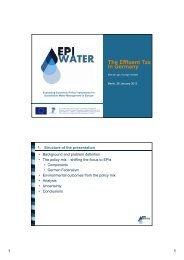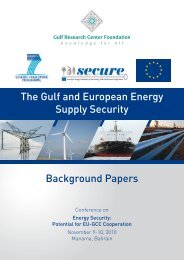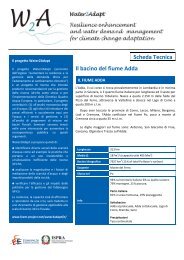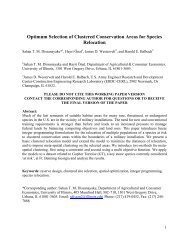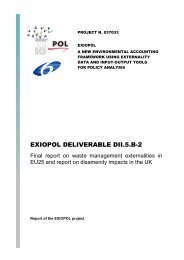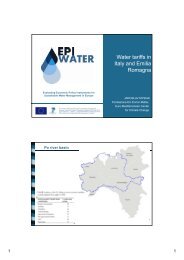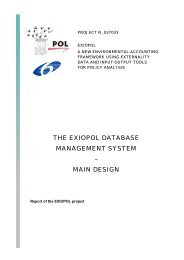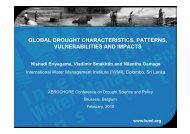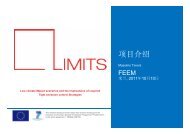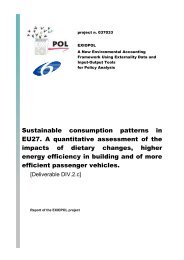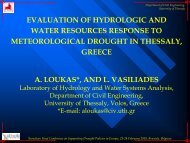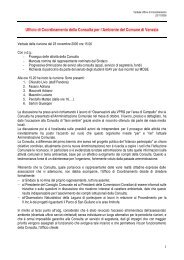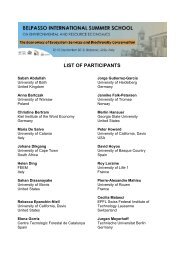sufri - Feem
sufri - Feem
sufri - Feem
Create successful ePaper yourself
Turn your PDF publications into a flip-book with our unique Google optimized e-Paper software.
Sustainable Strategies of Urban Flood Risk Management<br />
with non-structural Measures to cope with the Residual<br />
Risk<br />
Technical Session 1/2<br />
UPV-I<br />
Luigi Natale Gabriella Petaccia<br />
20-10-2010 12-09-2011<br />
27-07-2009<br />
ERA-NET CRUE SUFRI<br />
1
Technical Session 1/2<br />
The project SUFRI<br />
improvement of flood risk management with non-structural measures<br />
implement sustainable flood risk management, for<br />
advanced warning systems<br />
vulnerability analysis<br />
risk communication<br />
To achieve this goal six project partners from four European countries<br />
Austria, Germany, Italy and Spain<br />
worked within the ERA-Net CRUE initiative for the period of 2009 - 2011<br />
recommendations for good practice of risk based management in flood-prone urban<br />
areas in consideration of the national differences<br />
analyse national procedures, efforts of rehabilitation, public risk perception,<br />
case studies of vulnerable European cities where flood events occurred in the recent<br />
past have been undertaken<br />
12-09-2011<br />
27-07-2009<br />
ERA-NET CRUE SUFRI<br />
2
Technical Session 1/2<br />
OBJECTIVES of SUFRI<br />
Flood warning and floods in urban areas, especially for small catchment areas, are still<br />
research topic<br />
Many recent research projects have focused on these topics like URBAS 2008, EWASE<br />
2008, UrbanFlood 2010. Experiences of practical applications are still scarce<br />
The project intention is<br />
provide an overview about flood characteristics in urban areas to improve flood<br />
management, and about general components and benefits of early warning systems<br />
Different approaches have been used to reach this goal<br />
experiences with analogue warning systems<br />
weather data<br />
rainfall and flood forecast models<br />
flood maps and flood management plans<br />
all themes related with warning systems lead to recommendations for practitioners and<br />
authorities<br />
12-09-2011<br />
27-07-2009<br />
ERA-NET CRUE SUFRI<br />
3
Regarding the basis principles of ERA-Net CRUE<br />
resilience and community<br />
the aspect of public participation gains in importance<br />
participation of the public is seen as an important prerequisite design an effective risk<br />
communication for a crisis management<br />
Therefore, the project SUFRI fills in two research gaps<br />
provides empirical data on the subjective view of the citizens regarding natural hazards<br />
particularly regarding flooding, as well as the desired communication and information in the<br />
case of a flood occurring<br />
an international comparison between the chosen investigation areas takes place<br />
Technical Session 1/2 12-09-2011<br />
20-10-2010 27-07-2009<br />
ERA-NET CRUE SUFRI<br />
4
The project objective was divided into four main themes:<br />
•Warning systems<br />
•Risk assessment<br />
•Risk communication<br />
•Crisis management<br />
•Compilation of advanced warning systems<br />
key findings of the project<br />
•Compilation of risk communication strategies<br />
•SUFRI Methodology for pluvial and river flooding risk assessment in urban areas<br />
•SUFRI Method for risk awareness of the population<br />
•SUFRI Approach for crisis management planning<br />
•Examples of use in<br />
Austria, Germany, Italy and Spain and their trans-national comparison<br />
•International symposium UFRIM for communicating the research results<br />
Technical Session 1/2 12-09-2011<br />
20-10-2010 27-07-2009<br />
ERA-NET CRUE SUFRI<br />
5
Technical Session 1/2<br />
SUFRI project involves five case studies<br />
•Graz,<br />
•Dresden,<br />
•Lodi<br />
•Benaguasil<br />
•Arenys de Mar / Munt.<br />
12-09-2011<br />
27-07-2009<br />
ERA-NET CRUE SUFRI<br />
6
Technical Session 1/2<br />
LODI TEST CASE<br />
12-09-2011<br />
27-07-2009<br />
ERA-NET CRUE SUFRI<br />
7
A 1D and 2D study of flood prone areas in Lodi was performed by the University of Pavia<br />
For the 1D model the river course is 130 km long<br />
Inside the river channel 35 obstructions - bridges, barrages, etc. - can strongly influence<br />
the river flow particularly upstream for quite a long distance<br />
The mathematical model used is based on shallow water equations written in a<br />
conservative form.<br />
The mathematical model is numerically integrated with finite volumes techniques with<br />
two different numerical schemes<br />
To estimate the roughness coefficient a method that refers to the formulation<br />
proposed by U.S. Geological Survey that correlate the roughness coefficient (using<br />
Manning) with the dimension of the grains in the river bed and the vegetation in the<br />
riverbed was used<br />
Technical Session 1/2<br />
12-09-2011<br />
27-07-2009<br />
ERA-NET CRUE SUFRI<br />
8
For the 2D model the geometric description of the urban areas is represented by a<br />
Digital Terrain Model (DTM) 5 m x 5m<br />
inundated areas, the velocity field, the water levels were computed<br />
Technical Session 1/2<br />
Inundated areas in Lodi town for 20 year return period<br />
12-09-2011<br />
27-07-2009<br />
ERA-NET CRUE SUFRI<br />
9
Technical Session 1/2<br />
Inundated areas in Lodi town for 200 year return period<br />
12-09-2011<br />
27-07-2009<br />
ERA-NET CRUE SUFRI<br />
10
Technical Session 1/2<br />
12-09-2011<br />
27-07-2009<br />
ERA-NET CRUE SUFRI<br />
11
Specific Outcomes<br />
Technical Session 1/2<br />
WP2: Advanced Warning Systems of Small Urban Catchment Areas<br />
•Compilation of advanced warning systems of small urban areas<br />
•Experiences in different European countries<br />
12-09-2011<br />
27-07-2009<br />
ERA-NET CRUE SUFRI<br />
12
Lessons Learned<br />
•Flood warning system is the non-structural measure with best cost-benefit-ratio<br />
•Rainfall-runoff-models for small catchment areas are still a topic of scientific projects<br />
•It is beneficial to analyze automatic warning systems in case of other accidents and disasters too to get<br />
additional information and input<br />
•Recommendation of installation of additional rainfall and river gauges at smaller rivers to get better data<br />
•Sirens, diaphones or loudspeakers are cost efficient methods to disseminate warning messages to a local<br />
limited set of affected people even if they have no access to public media<br />
•Flood warning messages should be clear, simple, understandable and without subjunctives<br />
•Additional information should be provided by community helpline, TV, radio and the World Wide Web<br />
•Centralised institutions can provide the needed expert knowledge and should be responsible for centralized<br />
data collection<br />
•The response system should be centralized too, but on a lower administration level<br />
•Hazard, risk or inundation maps are important for exact action planning in case of flood<br />
•The review of warning systems was often only triggered by extreme flood events<br />
•Early warning systems today can benefit more by establishing short communication<br />
Technical Session 1/2<br />
12-09-2011<br />
27-07-2009<br />
ERA-NET CRUE SUFRI<br />
13
Specific Outcomes<br />
Technical Session 1/2<br />
WP3-Residual Risk and Vulnerability Analysis<br />
•Tool to support flood risk evaluation in urban areas, applicable to inform<br />
authorities, local entities and stakeholders on decision-making for establishment<br />
of strategies for risk reduction<br />
•F-N and F-D curves to represent risk results (societal and economic flood risk),<br />
useful for defining tolerability criteria for flood risk<br />
•Evaluation method of the effects of several flood protection measures<br />
•Applicable for different levels of information: from basic evaluations on flood<br />
risk to highly detailed estimations<br />
•Case study examples<br />
Lessons Learned<br />
•Risk evaluations from low level of information require assumptions → more<br />
conservative because uncertainty in results is high (particularly in the number of<br />
people exposed to a flood and hydraulic characteristics)<br />
•In case examples, economic risk has more significance than societal risk<br />
However, there is no doubt that public education and warning systems have an<br />
effect on risk reduction<br />
12-09-2011<br />
27-07-2009<br />
ERA-NET CRUE SUFRI<br />
14
SUFRI methodology is based on the identification of all the important factors that<br />
influence risk quantification: sources of flood risk (river, heavy rainfall, defense failure,<br />
inefficient drainage system, etc.), vulnerability of the study area, etc.<br />
The TU of Valencia has developed IPRESAS software and a dedicated methodology<br />
that provides a scheme that can be applied for different levels of information: from<br />
basic evaluations on flood risk to highly detailed estimations<br />
The use of F-N curves enables the comparison of the current situation of the urban<br />
area with other situations from the consideration of non-structural measures.<br />
Uncertainty on the results will depend on available data and the level of detail of<br />
hydrologic and hydraulic models or calculations<br />
Technical Session 1/2<br />
12-09-2011<br />
27-07-2009<br />
ERA-NET CRUE SUFRI<br />
15
Annual Probability of Exceedance, F<br />
Technical Session 1/2<br />
1<br />
0.1<br />
0.01<br />
0.001<br />
WP3: RISK ASSESSMENT<br />
F-N CURVE. BASE CASE vs PFR , LODI<br />
0.001 0.01 0.1 1 10<br />
Number of potential fatalities, N<br />
12-09-2011<br />
27-07-2009<br />
PFR<br />
BASE<br />
ERA-NET CRUE SUFRI<br />
16
Annual probability of exceedance, F<br />
1<br />
0.1<br />
0.01<br />
0.001<br />
Technical Session 1/2<br />
F -D CURVE BASE CASE VS PFR, LODI<br />
€ 100,000.00 € 1,000,000.00 € 10,000,000.00 € 100,000,000.00<br />
Potential economic losses (€), D<br />
12-09-2011<br />
27-07-2009<br />
PFR<br />
BASE<br />
ERA-NET CRUE SUFRI<br />
17
Specific Outcomes<br />
Technical Session 1/2<br />
WP4: Risk Communication<br />
•Questionnaire in 4 languages (English, German, Italian, Spanish) to achieve data of<br />
the subjective view of the citizens about natural threats (especially flood), the desired<br />
communication and information in case of a flood event<br />
•Guidance for hypothesis and connectivity testing regarding predefined questions<br />
(factor / cluster analysis)<br />
•Guidance for successful risk communication<br />
•Experiences in European cities (all case studies): public opinion poll<br />
•Experiences in European cities (Graz, Benaguasil): information campaigns<br />
Lessons Learned<br />
•The population feels a lack of information during a flood event<br />
•Stakeholder, action forces and population need to be involved in the developing<br />
process of crisis management<br />
•The willingness for cooperation is higher if people have the feeling of taken seriously.<br />
12-09-2011<br />
27-07-2009<br />
ERA-NET CRUE SUFRI<br />
18
27-07-2009<br />
Technical Session 1/2 12-09-2011<br />
ERA-NET CRUE SUFRI<br />
19
The return rates range between 25 and 64 per cent and are thus to be recorded as<br />
exceptional in each survey area from a social scientific perspective. Only the return rate in<br />
Arenys de Mar / Munt is with 4% quite low<br />
During the realization of the opinion poll different experiences have been gained<br />
1. It’s absolute necessary to adapt the modality of the investigation to the local circumstances<br />
in the case study area. Depending on the attitude and atmosphere regarding the authorities<br />
sometimes it could be useful to have them as partner, sometimes not<br />
2. It is advantageous if the interviewer speaks the same dialect/language as the interviewed<br />
persons (e.g. Catalan in Spain).<br />
Technical Session 1/2<br />
12-09-2011<br />
27-07-2009<br />
ERA-NET CRUE SUFRI<br />
20
27-07-2009<br />
Technical Session 1/2 12-09-2011<br />
ERA-NET CRUE SUFRI<br />
21
Threat by floods<br />
The results show, that the feeling of threat concerning floods is extraordinarily high in Lodi (46% feel<br />
threatened very much), followed by Graz (31%). Surprisingly only 5% of the people in Arenys de Mar / Munt<br />
feel threatened by floods. In Benaguasil and Dresden the quota of people who feel threatened and who not is<br />
relatively balanced. However the number of citizens who feel threatened very much is quite low (6% and 1%).<br />
Technical Session 1/2<br />
12-09-2011<br />
27-07-2009<br />
ERA-NET CRUE SUFRI<br />
22
Measures in order to reduce flood risk – early warning<br />
In Arenys de Mar / Munt 76%, in Dresden 73% and in Lodi 62% are of the opinion that early warning is<br />
most reasonable or reasonable to reduce flood risk. In Graz 46% of the people think so, but here the<br />
number of those who are in the opinion it’s reasonable is with 28% higher. In Benaguasil the same<br />
interesting tendency could be observed. 40% believe early warning is most reasonable but at the same<br />
time 47% that is least reasonable.<br />
Technical Session 1/2<br />
12-09-2011<br />
27-07-2009<br />
ERA-NET CRUE SUFRI<br />
23
Measures in order to reduce flood risk – self-protection<br />
In the Spanish case studies self-protection is assigned more sensuousness, e.g. Benaguasil and Arenys de Mar<br />
/ Munt 69% most reasonable or reasonable. In Benaguasil at the same 24% stated self-protection as least<br />
reasonable. In Dresden 47% of the interviewed people think that it’s least reasonable. In Graz and Lodi the<br />
opinions are more in the middle field reasonable or less reasonable.<br />
Technical Session 1/2<br />
12-09-2011<br />
27-07-2009<br />
ERA-NET CRUE SUFRI<br />
24
Measures in order to reduce flood risk – protective structures<br />
In all case studies the tendency is clear. Protective structures are considered as most reasonable<br />
or reasonably by the majority of the respondents.<br />
Technical Session 1/2<br />
12-09-2011<br />
27-07-2009<br />
ERA-NET CRUE SUFRI<br />
25
Technical Session 1/2<br />
Evaluation of general statements<br />
In the case studies the evaluation of the general statements listed below have shown the same clear<br />
tendency<br />
•Man cannot control nature entirely: tendency applies<br />
•One can protect oneself from floods completely: tendency does not apply<br />
•There remains always a residual risk with natural hazards: tendency applies<br />
•When I moved to this area I was aware of the flood risk: tendency does not apply<br />
•I have coped psychologically with the previous flood events very well: tendency applies<br />
•During heavy rain I remember previously flood events: tendency applies<br />
•Because of the financial burden I can barely afford a holiday: tendency does not apply<br />
The results show, that most of the people are aware of the fact that there is always a residual risk<br />
Additionally it shows the importance of awareness training regarding the flood risk in the residential area<br />
Affected by floods<br />
in Arenys de Mar / Munt only 7% of the interviewed people have been affected by floods in the last 10<br />
years<br />
These percentage is much higher (> 60%) in the other case studies<br />
Frequency of affectedness<br />
In Dresden and Lodi the majority of the people have been affected once in the last 10 years<br />
In Graz and Benaguasil flood events have happened more often<br />
12-09-2011<br />
27-07-2009<br />
ERA-NET CRUE SUFRI<br />
26
Health problems<br />
The percentage of those who suffered from health problems after the last flood events is very low for Dresden<br />
and Graz.<br />
In Benaguasil none of the respondents had any health problems<br />
The highest percentage can be registered for Lodi<br />
The most indicated types of health problems in all case studies are panic attacks/anxiety states, insomnia,<br />
irritability/anger and restlessness<br />
Preferred source of information in case of emergency<br />
in all case studies, except Lodi, people like to be informed by the media<br />
in all case studies, except Benaguasil, people like to be informed by emergency services.<br />
the majority of the interviewed persons don’t like to obtain information in case of emergency by<br />
internet, on-site information centers, by friends / relatives<br />
Information about flood issues on a regular basis<br />
Regarding this topic the results show, that information by the media is preferred in all case studies<br />
Level of information during the last flood event<br />
The results show clearly that the majority of the people felt informed very badly during the last flood event<br />
The percentage is especially high in Lodi with 85%, followed by Benaguasil with 68%, Graz 53% and<br />
Dresden 52%<br />
Due to a too low number of affected people an analysis was not possible for Arenys de Mar / Munt<br />
Technical Session 1/2<br />
12-09-2011<br />
27-07-2009<br />
ERA-NET CRUE SUFRI<br />
27
Assessment of available time span<br />
The available time span was far too short for most of the interviewed persons:<br />
Dresden 63%, Graz 56%, Lodi 82%<br />
Due to a too low number of affected people an analysis was no possible for Arenys de Mar / Munt. And<br />
Benaguasil<br />
Knowledge about self-protection measures<br />
The majority of the interviewed people in Benaguasil (73%) and Graz (67%) have indicated to know<br />
measures for self-protection<br />
In Arenys de Mar / Munt 71%, in Dresden 67% and in Lodi 62% don’t know about this measures<br />
Protective measures in the future<br />
In all case studies, except in Benaguasil, the majority of the people will take protective measures<br />
in the future<br />
Assessment of solidarity efforts in the neighborhood<br />
There is a clear tendency in all case studies, except Benaguasil, to assess the solidarity efforts in the<br />
neighborhood positive<br />
In Benaguasil the opinions concerning this topic differ wider than in the other case studies,<br />
although 27% evaluated the solidarity efforts in the neighborhood as very good<br />
Technical Session 1/2<br />
12-09-2011<br />
27-07-2009<br />
ERA-NET CRUE SUFRI<br />
28
Technical Session 1/2<br />
Case study Lodi<br />
Despite the fact that the last flood event in Lodi happened in 2002, people in Lodi seem to<br />
have experienced this events very intensely.<br />
In comparison to other case studies difference in the answers are conspicuous<br />
They<br />
•feel most threatened by floods<br />
•rated the flood risk for them personally, inhabitants of their house and of their<br />
neighbourhood<br />
•highest rated their personal damage regarding material and financial causalities highest<br />
•rated their personal damage regarding health problems highest<br />
•rated the statement “I have coped psychologically with the previous flood events very well”<br />
with 46% rather applies and 32% applies. A clear difference to the other case studies,<br />
which answered with >60% with “applies” is noticeable<br />
•stated to need the longest time to prepare sufficiently for a flood<br />
•don’t like to be informed by the media as single case study<br />
•stated with the highest percentage (86%) to feel uncomfortable because of missing<br />
information<br />
•show the highest percentage regarding a very bad level of information during the last flood<br />
event<br />
12-09-2011<br />
27-07-2009<br />
ERA-NET CRUE SUFRI<br />
29
Technical Session 1/2<br />
GRAZIE PER<br />
L’ATTENZIONE<br />
12-09-2011<br />
27-07-2009<br />
ERA-NET CRUE SUFRI<br />
30



